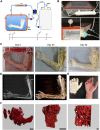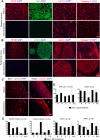Perfusion decellularization of a human limb: A novel platform for composite tissue engineering and reconstructive surgery
- PMID: 29352303
- PMCID: PMC5774802
- DOI: 10.1371/journal.pone.0191497
Perfusion decellularization of a human limb: A novel platform for composite tissue engineering and reconstructive surgery
Abstract
Muscle and fasciocutaneous flaps taken from autologous donor sites are currently the most utilized approach for trauma repair, accounting annually for 4.5 million procedures in the US alone. However, the donor tissue size is limited and the complications related to these surgical techniques lead to morbidities, often involving the donor sites. Alternatively, recent reports indicated that extracellular matrix (ECM) scaffolds boost the regenerative potential of the injured site, as shown in a small cohort of volumetric muscle loss patients. Perfusion decellularization is a bioengineering technology that allows the generation of clinical-scale ECM scaffolds with preserved complex architecture and with an intact vascular template, from a variety of donor organs and tissues. We recently reported that this technology is amenable to generate full composite tissue scaffolds from rat and non-human primate limbs. Translating this platform to human extremities could substantially benefit soft tissue and volumetric muscle loss patients providing tissue- and species-specific grafts. In this proof-of-concept study, we show the successful generation a large-scale, acellular composite tissue scaffold from a full cadaveric human upper extremity. This construct retained its morphological architecture and perfusable vascular conduits. Histological and biochemical validation confirmed the successful removal of nuclear and cellular components, and highlighted the preservation of the native extracellular matrix components. Our results indicate that perfusion decellularization can be applied to produce human composite tissue acellular scaffolds. With its preserved structure and vascular template, these biocompatible constructs, could have significant advantages over the currently implanted matrices by means of nutrient distribution, size-scalability and immunological response.
Conflict of interest statement
Figures



Similar articles
-
Perfusion-decellularization of human ear grafts enables ECM-based scaffolds for auricular vascularized composite tissue engineering.Acta Biomater. 2018 Jun;73:339-354. doi: 10.1016/j.actbio.2018.04.009. Epub 2018 Apr 11. Acta Biomater. 2018. PMID: 29654989
-
Decellularized skin/adipose tissue flap matrix for engineering vascularized composite soft tissue flaps.Acta Biomater. 2016 Apr 15;35:166-84. doi: 10.1016/j.actbio.2016.02.017. Epub 2016 Feb 12. Acta Biomater. 2016. PMID: 26876876 Free PMC article.
-
Procurement and Perfusion-Decellularization of Porcine Vascularized Flaps in a Customized Perfusion Bioreactor.J Vis Exp. 2022 Aug 1;(186). doi: 10.3791/64068. J Vis Exp. 2022. PMID: 35969081
-
Methods of tissue decellularization used for preparation of biologic scaffolds and in vivo relevance.Methods. 2015 Aug;84:25-34. doi: 10.1016/j.ymeth.2015.03.005. Epub 2015 Mar 16. Methods. 2015. PMID: 25791470 Review.
-
[Recent research progress of decellularization of native tissues].Sheng Wu Yi Xue Gong Cheng Xue Za Zhi. 2012 Oct;29(5):1007-13. Sheng Wu Yi Xue Gong Cheng Xue Za Zhi. 2012. PMID: 23198451 Review. Chinese.
Cited by
-
Decellularized skeletal muscles display neurotrophic effects in three-dimensional organotypic cultures.Stem Cells Transl Med. 2020 Oct;9(10):1233-1243. doi: 10.1002/sctm.20-0090. Epub 2020 Jun 24. Stem Cells Transl Med. 2020. PMID: 32578968 Free PMC article.
-
The Autonomization Principle in Vascularized Flaps: An Alternative Strategy for Composite Tissue Scaffold In Vivo Revascularization.Bioengineering (Basel). 2023 Dec 18;10(12):1440. doi: 10.3390/bioengineering10121440. Bioengineering (Basel). 2023. PMID: 38136031 Free PMC article. Review.
-
Techniques and Innovations in Flap Engineering: A Review.Plast Reconstr Surg Glob Open. 2022 Sep 21;10(9):e4523. doi: 10.1097/GOX.0000000000004523. eCollection 2022 Sep. Plast Reconstr Surg Glob Open. 2022. PMID: 36168612 Free PMC article.
-
Regenerative medicine technologies applied to transplant medicine. An update.Front Bioeng Biotechnol. 2022 Sep 28;10:1015628. doi: 10.3389/fbioe.2022.1015628. eCollection 2022. Front Bioeng Biotechnol. 2022. PMID: 36263358 Free PMC article. Review.
-
Tissue-Engineered Grafts from Human Decellularized Extracellular Matrices: A Systematic Review and Future Perspectives.Int J Mol Sci. 2018 Dec 18;19(12):4117. doi: 10.3390/ijms19124117. Int J Mol Sci. 2018. PMID: 30567407 Free PMC article.
References
-
- Guyette JP, Gilpin SE, Charest JM, Tapias LF, Ren X, Ott HC. Perfusion decellularization of whole organs. Nature protocols. 2014;9(6):1451–68. doi: 10.1038/nprot.2014.097 . - DOI - PubMed
-
- Ott HC, Matthiesen TS, Goh SK, Black LD, Kren SM, Netoff TI, et al. Perfusion-decellularized matrix: using nature's platform to engineer a bioartificial heart. Nature medicine. 2008;14(2):213–21. doi: 10.1038/nm1684 . - DOI - PubMed
-
- Ott HC, Clippinger B, Conrad C, Schuetz C, Pomerantseva I, Ikonomou L, et al. Regeneration and orthotopic transplantation of a bioartificial lung. Nature medicine. 2010;16(8):927–33. doi: 10.1038/nm.2193 . - DOI - PubMed
-
- Gilpin SE, Guyette JP, Gonzalez G, Ren X, Asara JM, Mathisen DJ, et al. Perfusion decellularization of human and porcine lungs: bringing the matrix to clinical scale. The Journal of heart and lung transplantation: the official publication of the International Society for Heart Transplantation. 2014;33(3):298–308. doi: 10.1016/j.healun.2013.10.030 . - DOI - PubMed
-
- Guyette JP, Charest JM, Mills RW, Jank BJ, Moser PT, Gilpin SE, et al. Bioengineering Human Myocardium on Native Extracellular Matrix. Circulation research. 2016;118(1):56–72. doi: 10.1161/CIRCRESAHA.115.306874 . - DOI - PMC - PubMed
Publication types
MeSH terms
Grants and funding
LinkOut - more resources
Full Text Sources
Other Literature Sources
Medical

